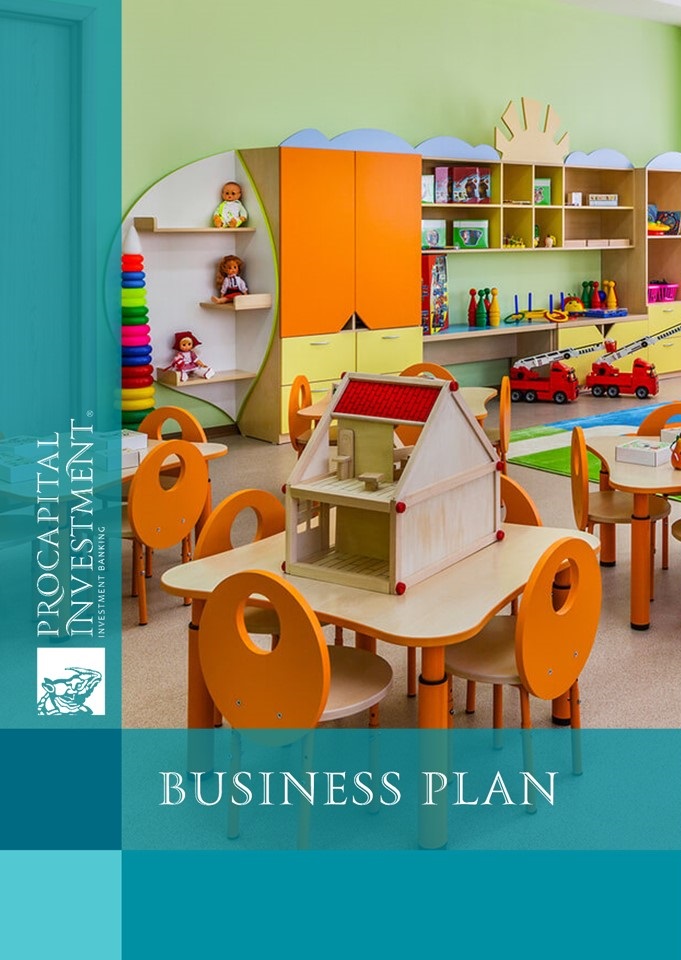Business idea for a small business in Ukraine. Open a private kindergarten

General characteristics
| Date of Preparation: | November 2015 year |
| Number of pages: | 57 pages, including 16 applications, 32 tables, 17 figures (document prepared in Ukrainian) |
| Graphs and charts: | 17 |
| Tables: | 19 |
| Payment method: | prepayment |
| Production method: | digital in Word + financial model in Excel |
17999 UAH
- This project can be updated with your volumes, period and location
- You can order business plan for other project - сontact us
- You can also order market research for your business




The concept of the project:
Today in the field of early childhood education to a situation of acute shortage of childcare facilities with qualitative approach in the education and upbringing of children. Reduction in the network of public institutions is affected all cities of Ukraine. In connection with this reduction in public kindergartens now can cover only 63.5% of children. Most of the problems with children's educational institutions in Ternopil, Kharkiv, Uzhgorod, Kamenetz-Podolsk, where a hundred places have 140-156 children. The main reason for this situation is the increase in the birth rate in recent years and the migration to the big cities. Despite the emergence of private kindergartens until this niche in the country remains underdeveloped and potentially attractive to private investors.
The purpose of the Project is to open the pre-school for 30 people in one of the major cities of Ukraine. As part of the development of the Project has been carried out the selection of equipment to complete the work of a kindergarten, a list of necessary permits and the method of its preparation, composed staffing kindergarten. The financial model includes calculations of profitability and attractiveness, as well as forward-looking statements of income and cash flows.
Such a project can be implemented in any large city in Ukraine, where a shortage of pre-school facilities for children.
Project is characterized by such financial performance indicators:
Project is characterized by such financial performance indicators:
- billing period - 3 years;
- total cost of the project - 432 247 UAH.;
- internal rate of return - 28,9%;
- discounted payback period - 2.52 years;
- profitability of investments - 1,23;
- ROI - 147%;
- return on sales - 17,5%
This business idea opens up the possibility of its initiators to occupy its niche in the market of providing the education and upbringing of children. In addition to economic benefits for the initiator, the Project has a positive social impact, which is to create new jobs, create additional revenue in the form of a single tax and social charges on salaries. Moreover, the project influences the improvement of the local social infrastructure of the city, where it can be implemented.
<p
Content:
1. PROJECT SUMMARY
2. PROJECT
2.1. PROJECT DESCRIPTION
2.1.1. The concept of the project and a description of the business idea
2.1.2. Location of the Project, the circuit area
2.1.3. The manufacturing process of the project. Equipment and assets
2.1.4. Frames
2.1.5. Licensing documentation
2.2. FINANCIAL ASSESSMENT PROJECT
2.2.1. Options Project
2.2.2. Initial data for the calculations and their reasoning
2.2.3. Sources of financing of the Project. Targeted investment direction and schedule of investments
2.2.4. The sales plan
2.2.5. Income and expenses
2.2.6. Statement of Cash Flows
2.2.7. Break-even point
2.2.8. Indicators of investment attractiveness and profitability of the Project
2.3. SWOT - analysis
3. CONCLUSIONS
Applications:
Annex 1. Aggregates for Project
Annex 2. Project Settings
Annex 3. Sources of funding and implementation schedule of the Project
Annex 3. Sources of funding and implementation schedule of the Project
Annex 4. The cost of equipment for the Project
Annex 5. Calculation of depreciation on the Project
Annex 5. Calculation of depreciation on the Project
Annex 6. Staffing the Project
Annex 7. Projected sales plan
Annex 7. Projected sales plan
Annex 8. Projected profit and loss statement for the project
Annex 9. Projected statement of cash flows
Annex 10. Calculation of break-even point
Annex 11. Calculation of investment attractiveness and profitability of the Project
List of Tables:
Table 1. Staffing table
Table 2. General tab of the Project
Table 3. Settings of work
Table 4. Taxation for Project
Table 5. Directions and schedule of investment funds
Table 6. The sales plan for the Project
Table 7. Projected profit and payments to the Project
Table 8. Statement of Cash Flows for the Project
Table 9. Break-even sales volume for the Project, 1-3 years
Table 10. The minimum cost of services for the Project to work at breakeven, 1-3 years
Table 11. Stock of financial strength for the Project
Table 12. Performance indicators that the investment attractiveness of the Project
List of graphs and charts:
Figure 1. The structure of investment funds
Figure 2. The internal rate of return
Figure 3. The discounted payback period











